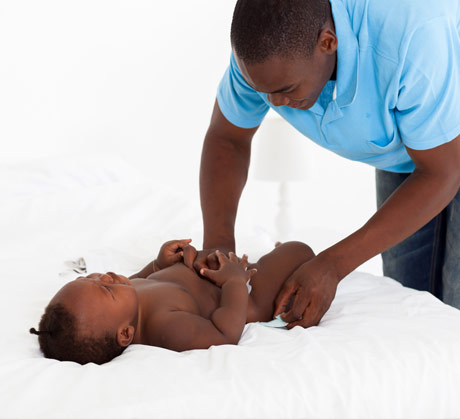How can I tell if my baby has nappy rash?
Nearly all babies get nappy rash, especially around nine months of age – this is often due to changes in the gut after starting on solid food, which in turn affects the frequency and consistency of your baby’s poo. Diarrhoea can also cause a nasty and painful rash. It’s pretty distinctive, and you’ll see a red rash that appears as a result of the skin reacting to bacteria in wee or, most commonly, poo. It can be patchy or spread over the whole nappy area, and sometimes you might see spots and tiny blisters. It’s usually sore and feels warm to touch. Most babies get mild nappy rash at some time or another, and may not appear to feel sore, but a more severe rash will make your child feel very uncomfortable.
Why do babies get nappy rash?
Young babies have super-sensitive skin, which is more prone to rashes and infection than adult skin. Nappy rash is very common, and even babies with the most vigilant of parents get it, so try not to feel too guilty about it – just remember to treat it as soon as you see the first signs. Common causes are:
- Leaving a dirty or wet nappy on too long
- Chafing of the skin by clothes or nappies
- Chemicals found in soap, baby bath products or washing powders
- Some baby wipes – e.g. fragranced
- Excess swallowing of saliva or mucus during teething or a cold
- Diarrhoea.
How can I prevent my baby getting nappy rash?
Preventing nappy rash is easier than treating it, so stick to these simple rules:
- Change your baby’s nappy frequently – especially if she’s done a poo. Leaving poo against your baby’s warm bottom in a moist environment is asking for trouble, so be vigilant. For little babies, this can mean up to eight nappy changes a day – older babies require fewer changes but be mindful that it’s this age group who are most likely to suffer (and produce bigger poos when they do go).
- Each time you change her nappy, you need to clean the whole nappy area thoroughly. Use plain water or plain baby wipes – try to avoid using fragranced ones and make sure all the skin and folds around the bottom area are thoroughly dried after being cleaned.
- Let your baby have some nappy-free time. Lie her down on a changing mat or clean towel and let her have a good kick about (babies love this), or let her crawl around with a bare bottom. Fresh air is a great way to prevent nappy rash. When your baby has to have a nappy, keep it loose enough so air can still circulate and try to avoid lots of layers of clothes as this creates the warm, moist environment bacteria love.
- After cleaning, you can apply a thin layer of a barrier cream over the whole affected area. Don’t apply it too thickly as this will lead to more moisture in the area and possible chaffing from the nappy and can interfere with absorbability of disposable nappies.
How can I treat my baby’s nappy rash?
If your baby gets nappy rash, you need to treat it quickly. Clean as above, and use a specific nappy rash cream on the rash afterwards – ask your chemist, doctor or health visitor to recommend one.
If it’s not healing or you’re concerned it’s getting infected, see your doctor without delay. Untreated nappy rash can develop into a yeast infection such as thrush (you may see pus-filled pimples on your baby’s skin) or a bacterial infection. If this is the case, your doctor will give your baby medicine or cream to help get rid of the infection. Taking the steps outlined above should help to stop it recurring.
Could it be thrush?
Unfortunately the germ that causes thrush, called Candida, loves inflamed skin and skin creases. If your baby’s rash becomes a deeper red and develops red or white pimples, it could be thrush and you will need an antifungal cream from a pharmacist or on prescription from your GP. It’s important to continue using this for a week or so after the rash clears up, to make sure it doesn’t come back.
DISCLAIMER
This article is for information only and should not be used for the diagnosis or treatment of medical conditions. Essential Parent has used all reasonable care in compiling the information from leading experts and institutions but makes no warranty as to its accuracy. Consult a doctor or other health care professional for diagnosis and treatment of medical conditions. For details
click here.
